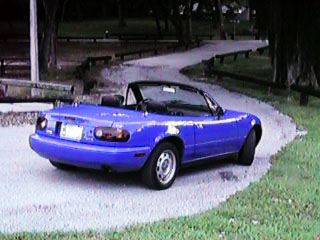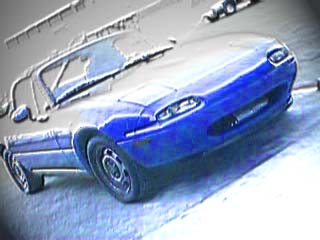

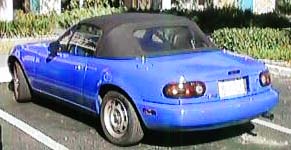 What was sold to my by Corky Bell as a System IV turbo was really the first
"Flying Miata Turbo."
It is essentially the BEGI System III, but with a very
free-flow exhaust system - basically a 2.5" pipe all the way back, passing through
a Jackson Racing free-flow catalytic converter and a Borla straight-through tailpipe.
Also included in the system are a larger intercooler, uprated fuel injectors (310
instead of the stock 220), and a MiataLink fuel and ignition mapping computer that
replaces the stock computer. BEGI uses a Warner IHI5 (small, but more than big
enough for 1600cc) turbine, and a custom manufactured heat-shield and airbox
that look very slick, and breathes through a Miata stock-sized K&N airfilter.
What was sold to my by Corky Bell as a System IV turbo was really the first
"Flying Miata Turbo."
It is essentially the BEGI System III, but with a very
free-flow exhaust system - basically a 2.5" pipe all the way back, passing through
a Jackson Racing free-flow catalytic converter and a Borla straight-through tailpipe.
Also included in the system are a larger intercooler, uprated fuel injectors (310
instead of the stock 220), and a MiataLink fuel and ignition mapping computer that
replaces the stock computer. BEGI uses a Warner IHI5 (small, but more than big
enough for 1600cc) turbine, and a custom manufactured heat-shield and airbox
that look very slick, and breathes through a Miata stock-sized K&N airfilter.
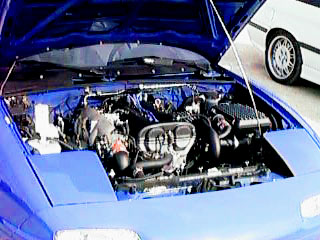 Bill Cardell (of the
Dealer Alternative)
had tested the injectors and computer on his turbo equipped Miata for several
months before shipping the system to BEGI, so we were fairly confident in
the computer. The computer deserves a page all its own, but the short
explanation is that it uses manifold air pressure and engine RPM to determine
a point in a lookup table that controls both injector duty cycle and ignition
advance. I'd really like it to read (and take into account) intake manifold
air temprature, since that can have up to a 20% effect on oxygen content per
liter, but so far the system seems at least functional, and much better than
trying to patch the stock computer.
Bill Cardell (of the
Dealer Alternative)
had tested the injectors and computer on his turbo equipped Miata for several
months before shipping the system to BEGI, so we were fairly confident in
the computer. The computer deserves a page all its own, but the short
explanation is that it uses manifold air pressure and engine RPM to determine
a point in a lookup table that controls both injector duty cycle and ignition
advance. I'd really like it to read (and take into account) intake manifold
air temprature, since that can have up to a 20% effect on oxygen content per
liter, but so far the system seems at least functional, and much better than
trying to patch the stock computer.
Even though it is a straight through exhaust, the Borla has the effect of making a cancellation resonance at about 4100 RPM which makes driving at that speed nice, smooth and very quiet. Even when it is at its loudest, the turbo chops up so much of the exhaust noise that I don't consider the car to be appreciably louder than stock. After living with the exhaust for 2 years, I do realize that it is louder - you can set off motion sensor car alarms by blipping the throttle - but I like it ;)
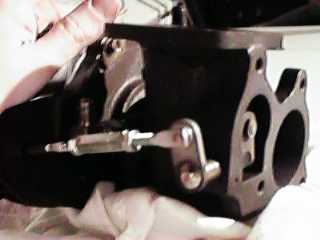 Unfortunately, the turbo wasn't ready to test until the day I was leaving
San Antonio, so we didn't really have time to work out the kinks. The major
kink was that the standard wastegate was too small for this application- the
boost was climbing uncontrollably in the upper RPM ranges. So, I shipped the
turbo back to San Antonio where BEGI ported the wastegate a bit. Now the boost can
be effectively limited with the wastegate, I've set it to around 9 psi- which is
all the Centerforce dual friction clutch can take. At night when the air is cold,
the clutch still slips a bit, but in the daytime it hangs on. The Centerforce
Dual-Friction clutch came out after 5000 mostly highway miles (anyone want to
buy a used clutch cheap?) and was replaced by a 1994 sized Kevlar clutch and
lightened flywheel - no slip problems anymore, and boost runs 12psi now.
Unfortunately, the turbo wasn't ready to test until the day I was leaving
San Antonio, so we didn't really have time to work out the kinks. The major
kink was that the standard wastegate was too small for this application- the
boost was climbing uncontrollably in the upper RPM ranges. So, I shipped the
turbo back to San Antonio where BEGI ported the wastegate a bit. Now the boost can
be effectively limited with the wastegate, I've set it to around 9 psi- which is
all the Centerforce dual friction clutch can take. At night when the air is cold,
the clutch still slips a bit, but in the daytime it hangs on. The Centerforce
Dual-Friction clutch came out after 5000 mostly highway miles (anyone want to
buy a used clutch cheap?) and was replaced by a 1994 sized Kevlar clutch and
lightened flywheel - no slip problems anymore, and boost runs 12psi now.
Some numbers comparing pre and post wastegate porting performance (tested under
similar conditions):
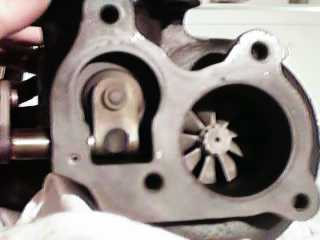
Before After
3rd gear 30-50mph 3.7 2.7
3rd gear 50-70mph 2.7 2.6
2nd gear 30-50mph 2.6 2.6 (yes, this is wierd, but it's what the stopwatch said)
Peak Boost (psi) 10.5 9.0
as you can see, porting the wastegate really helped low-rpm performance - and even
with the lower peak boost, the car still has roughly the same upper range power.
Strangely, the car doesn't feel as fast now, since the boost climbs to
around 8psi by about 3500RPM, and hangs there, there isn't the breathtaking
climbing power that came from the climbing boost situation when the wastegate
was too small.The second morning I took my car out of the garage I had a my first true sports-car experience with the Miata. First, there was oil on the floor! The drain line out of the Turbo seeped a little bit, I fixed that when re-installing the turbo after the wastegate porting. Second, and more dramatic, my fuel injectors were leaking all over the intake manifold. 15 minutes with a wrench and I had re-seated them and the leaking has stopped (for over 2500 miles now), I hope that doesn't recur too often - makes me want to put in an under hood fire bottle, $400 would be cheap insurance against engine fires. Two years down the road, I still haven't gotten the fire bottle, but then again, I haven't had any recuring leak problems either.
On the brighter side, the car is faster than stink! I have to hold the throttle off the floor to keep the boost from climbing too high, which is perhaps even more challenging than it sounds since I used to drive the car with the pedal firmly planted in the floormat most of the time. Now, first gear is capable of completely smoking a tire (on my non limited slip diff- that's changing soon), and second spools up in just a heartbeat. A friend of mine made the comment (while I was winding up third on a freeway on-ramp one day) that the non-turbo car sounds like a little lawnmower. Her new evaluation is that third gear is like a roller coaster free fall. If you were to start at 1500RPM, the engine pulls just a bit better than stock (probably due to the free flow intake and exhaust), from there the boost builds slowly until 2500RPM, then faster and faster and faster all the way to redline, the faster you go, the harder the car accelerates.
The wastegate climing boost problem was solved within a month, the slipping clutch was replaced within two months, and the Torsen limited slip went in after about a year, the car is downright respectable now. no more tendancy to spin at a flick of the right ankle, and it is even faster than before. Boost comes on anywhere after 2000 RPM and builds to 12psi by 3500 RPM (in 2nd gear, higher boost is available at lower RPM in higher gears.) If you're driving over 3500 RPM, just picture 4th gear accelerating as hard as 2nd gear does on a stock engine, good for miles and miles of smiles.
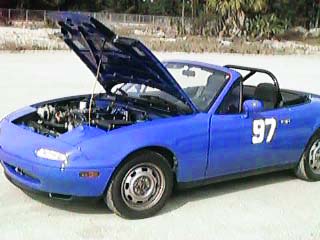 I took the car to an Autocross Jan 19, and the first time around (I got
there [160mi away] too late to walk the course), the boosted power didn't really
help me since I wasn't sure exactly where I was going. The second time around, I
used the power a bit more freely, and was able to easily control the car at
4500-6000 RPM in second gear through the obstacles. The third run was pure joy,
I suppose I should have been left foot braking for optimum times, but I was just
having a blast with the point and squirt power. If I had done a fun-run, I would
have played more with power oversteer, I was able to use it a bit on the third
run, but I was still trying for a good time and didn't want to overdo it.
Unfortunately, around town there has been too much traffic to do any "playing"
so far, and most of the 2000 miles I've put on the turbo so far have been highway.
I took the car to an Autocross Jan 19, and the first time around (I got
there [160mi away] too late to walk the course), the boosted power didn't really
help me since I wasn't sure exactly where I was going. The second time around, I
used the power a bit more freely, and was able to easily control the car at
4500-6000 RPM in second gear through the obstacles. The third run was pure joy,
I suppose I should have been left foot braking for optimum times, but I was just
having a blast with the point and squirt power. If I had done a fun-run, I would
have played more with power oversteer, I was able to use it a bit on the third
run, but I was still trying for a good time and didn't want to overdo it.
Unfortunately, around town there has been too much traffic to do any "playing"
so far, and most of the 2000 miles I've put on the turbo so far have been highway.
On the highway, the turbo is really in its element. Highway acceleration is very very temptingly quick. I haven't carried a stopwatch yet, and I really don't intend to do any testing until the uncontrolled boost problem is addressed. With the big intercooler, performance is also highly dependant on ambient tempratures which have been very low lately (good for performance).
Tickets, you ask? No bad ones so far - knock on wood. On the way from San Antonio to Miami, I did pass a off-duty officer on a twisty hilly two lane. Apparently, he couldn't pursue me (I think I know who it was, and he tried, but his new Dodge Intrepid did not follow for long), so he radioed ahead instead. I spent a pleasant 20 minutes with the local Sheriff while he figured out what I was all about - he let me go with a verbal warning. I also was stopped by a FHP trap just south of South Bay on US27, a very common trap location. They stopwatched me at 72mph in the 55, wrote me two $5 no points citations for lack of proof of insurance and lack of proof of registration, and a written warning (no points no fine) for the speed. That was a very good trip.
